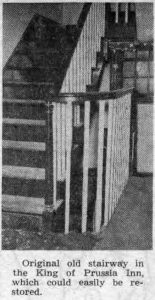In last week’s column, the writer told of a visit to the home of Mrs. Martha Wentworth Suffren, on Homestead road, after an invitation from “the grand old lady of Strafford” to hear her account, not only of the first telephone in this section of the Main Line, but also of the first attempts at sending telegraphic messages.
The telephone experiment was made over wires stretched through the trees between the present Rosato house, near Strafford station, and the home of Mrs. Suffren’s parents on Homestead road, now occupied by Mr. and Mrs. E. Brooke Matlack. The first effort to send a telegraphic message was made in the historic Old Eagle School House, still standing on the road to which it has given its name.
At the close of this informal interview with Mrs. Suffren, the latter invited the writer to go through her house and examine, more closely than on previous visits, the many pieces of old-fashioned furniture. The house, built in 1908 by Mr. Suffren at the almost unbelievably low cost of $8,000, stands on an acre and a half of ground, the only part of the 130 original acres in the old Wentworth tract still in the possession of a member of that family. It is a spacious white house which the visitor enters through a wide front door leading from the deep porch. The large, square hallway is flanked on the left by the living room with windows on three sides, and on the right by the dining room. A wide stairway, facing the front door, leads to the two upper floors, which contain seven bedrooms and four baths. All windows look out on a sweep of well-kept lawn with trees on every side.
From the west windows, Mrs Suffren can look out over the former farm lands which she roamed as a small girl. And to the south, she can glimpse the railroad tracks over which she watched President Lincoln’s funeral train make its slow way 90 years ago.
With “Friend Cane” (as Mrs. Suffren affectionately refers to her trusty walking stick) giving her the slight support she needs, Mrs. Suffren and the writer made their way through the first and second floors of her comfortable home. Many of the beautiful old pieces of furniture came to her through the well-known Emlen family of Philadelphia, of which Mrs. Suffren’s mother, the former Margaret Emlen, was a member.
The roomy old “Virginia sofa,” Mrs. Suffren says, has “always been there,” but of the original three handsome old mahogany chairs with their cane seats, only one still remains in Mrs. Suffren’s possession. So rare an antique is this chair that she has been told by a dealer that he has seen but one like it in all his travels. Near the sofa is a Lady Pembroke table, much used by its owner.
Then there is a mahogany desk which Mrs. Suffren thinks may have been made to order, since she has never seen another one similar in design. Among its interesting features is a set of secret drawers, placed behind the regular drawers. Directly in front of the secret drawers is a small mirror which lowers to reveal them. There is also a mahogany “writing table,” on which stands a pewter container with “blotting sand,” which, in days gone by, was sprinkled on the paper in order to absorb excess ink.
In the dining room across the hall is a clock that was a wedding gift to the Suffrens more than 70 years ago. Made of onyx, it has a lovely, gold-finished face. Chimes announce the hour. When the Suffrens moved away from their Strafford home to take up residence temporarily in Brooklyn, the clock suffered a mishap in the moving, and the top was broken. Since there was no onyx available for a new top, it was replaced by a wooden one painted black, which still serves its purpose. Among the other interesting objects in the dining room is an old silver gravy bowl and matching spoon with gracefully curved handle.
In the downstairs hallway are two fine old Sheraton pieces, a drop leaf table and a chair. Upstairs, in Mr. Suffren’s bedroom, is a quaint old “sleigh bed” of the Louis Philippe period. Mrs. Suffren explains that the term “sleigh bed” comes from the fact that its footboard is very high, like the front of an old-fashioned sleigh, which kept the snow, kicked up by the horses hooves, off the driver. In other rooms are two Jenny Lind beds.
Among the other treasures in this Strafford home is a picture of Lady Wentworth, about whom Longfellow wrote in his “Tales of a Wayside Inn.” And then there are the volumes of the Wentworth family biography, written by Congressman “Long” John Wentworth, so called because of his great height. Mrs. Suffren added that he was such a large man that he had to have four eggs for breakfast each morning to sustain him. At any rate, he spent 20 years and $20,000 in research for the writing of his voluminous family history.
And so it is that many mementoes, not only of her own long life, but also the lives of her forebears, surround Martha Wentworth Suffren as she approaches her 98th birthday, which will come on Thursday, October 10. In the serenity of her years she can look back on a full life, much of it spent on Homestead road, Strafford.

